Advanced Customer Configuration
Overview�
This section will cover all of the Advanced Properties available for Customers in Atria. Each option provides ways to customize user access, role assignments, organizational structure, and more for effective customer management.
The configuration options covered in this article can be found on the Edit Customer page, or in the Customer Portal Settings service. Navigate to each section to see how you can find these options within Atria.
Edit Customer
To find the configuration options stated below, navigate to Customer > Customers, expand your desired customer and click Edit Customer.
Edit Customer
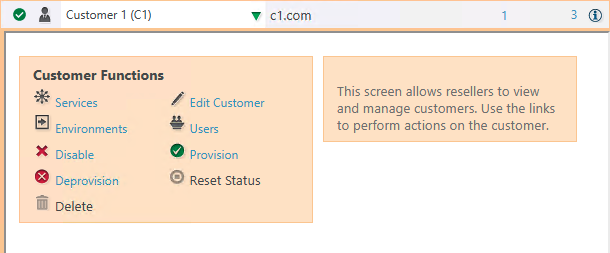
Customer Type
This dropdown lets you specify whether the customer is a standard, test, or demo customer.
Customer Type

Additional Options
The Additional Options section provides various fields for specifying different information about the customer.
Additional Options
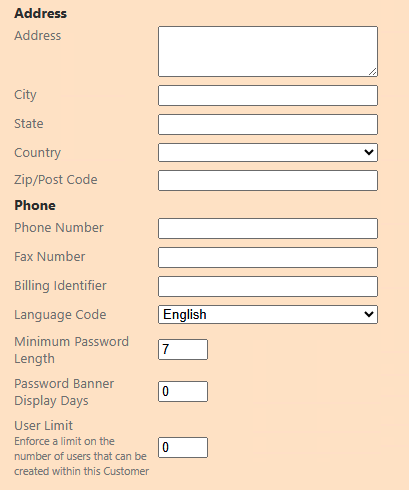
- Minimum Password Length: This sets the the minimum password length for all users under that customer. Further password requirements can be set here.
- User Limit: Enforce a limit on the number of users that can be created within this customer.
Domain Management
The Domain Management section allows you to manage the domains and DNS zones used for the customer.
- Domain Name: The domain assigned to the customer (e.g., atria.com).
- Primary: Indicates whether this domain is set as the primary domain.
- DNS Zone: Provides the option to create a local DNS zone to be managed by the DNS Service.
- Also Used By: Displays a count of customers who use this domain.
Domain Management

Use the Add button to add a domain, and the Update button to confirm your changes.
Password Configuration
The Advanced Properties section provides password configuration options for the customer, including Change password at next logon and Allow passwords to Never Expire which will apply to all users under that customer if enabled.
Password Configuration

Organizational Structure
The Organizational Structure setting allows you to change the grouping of users within Active Directory for segregation of users based on the configuration.
- Ungrouped: No specific grouping (default).
- By Department: Groups users by their departments (e.g., IT, HR).
- By Location: Groups users based on geographical locations.
- By Department, then by Location: First by department, then split by location.
- By Location, then by Department: First by location, then divided by departments.
- User Specified: Custom grouping as defined by the admin.
Organizational Structure
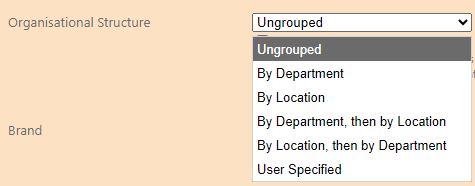
Update all users now: Ensures all users are updated to match the selected structure. Selecting this button before the provision of a customer will send a lightweight user re-provision to all users to move them to the specified structure.
Update all users now
Brand
The Brand section allows you to define the branding to be applied for the customer. Branding is a highly customisable feature, for more information navigate to Brand Management.
- URL: Custom URL branding (Uses the brand associated with the URL).
- Default: Uses the default Atria branding.
- Custom: Allows custom branding settings.
Brand

Restricted Roles
By default, Security Roles are enabled for use by every Customer in Atria. The Restricted Roles section allows you to deny access to specific roles for a customer. If a role is restricted:
- Existing users and sub-customers will lose access to the role.
- Restricted roles will no longer appear for assignment.
Restricted Roles

Check the box next to any Security Roles you would like to restrict.
Allowed Roles
The Allowed Roles section provides the option to allow customers to have access to extra roles.
The default available roles include:
- API User: Grants access to API functionalities.
- Audit and Reports: Enables auditing and reporting tools.
- Content Management Administrator: Allows access to content management administrative tasks.
Allowed Roles

Patterns
The Patterns section is used to configure the default naming conventions for users.
- User Display Name: Sets the format for user display names.
- Example: "Firstname Lastname" is selected, meaning user display names will appear as John Smith.
Patterns
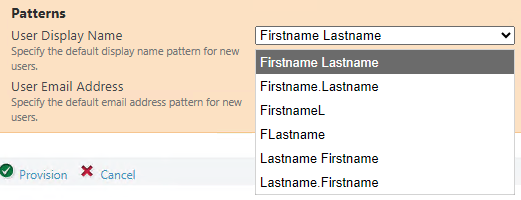
- User Email Address: Sets the default format for user email addresses.
- Example: "User Principle Name" ensures that email addresses are based on the user’s principal name.
User Email Address
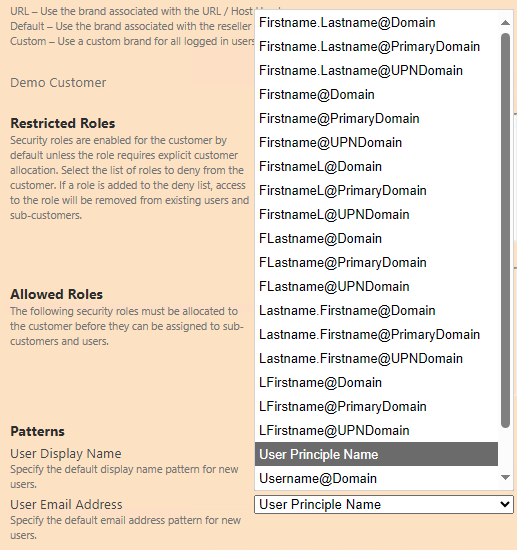
Customer Portal Settings
Customer Portal Settings
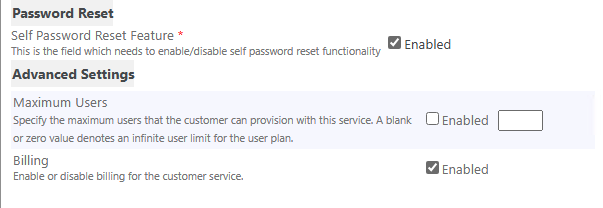
-
Self Password Reset Feature: Enabled/Disabled - This is the field which needs to enable/disable self password reset functionality
-
Maximum Users: Specify the maximum users that the customer can provision with this service. A blank or zero value denotes an infinite user limit for the user plan.
-
Billing: Enable or disable billing for the customer service.
Service Settings
Service Settings
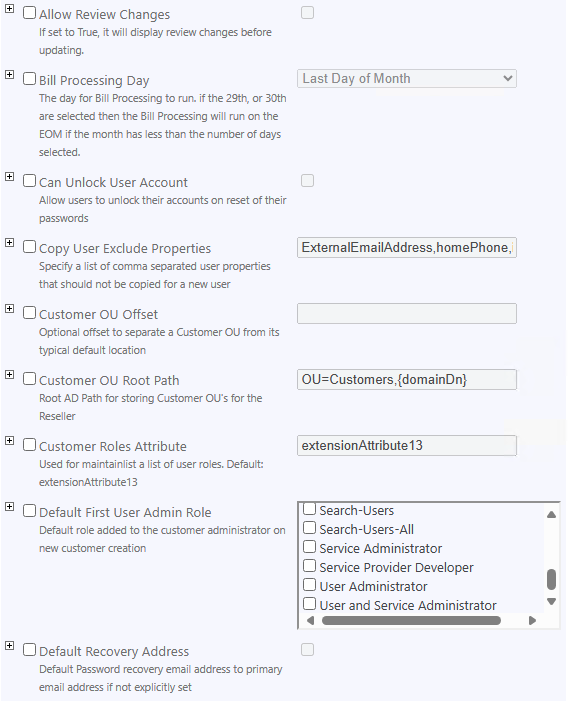
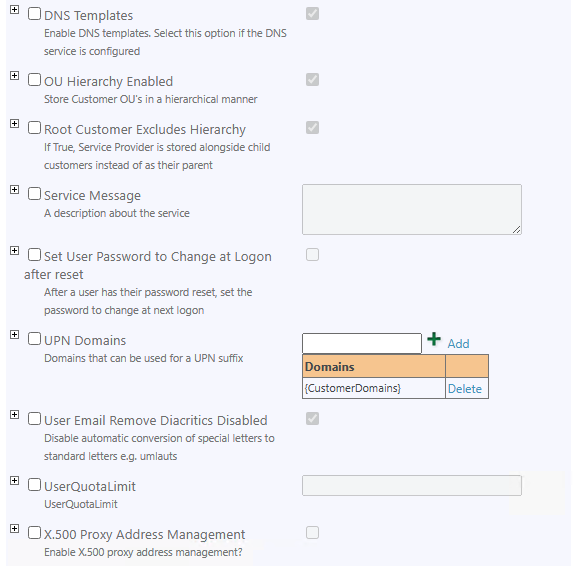
Further Service Settings
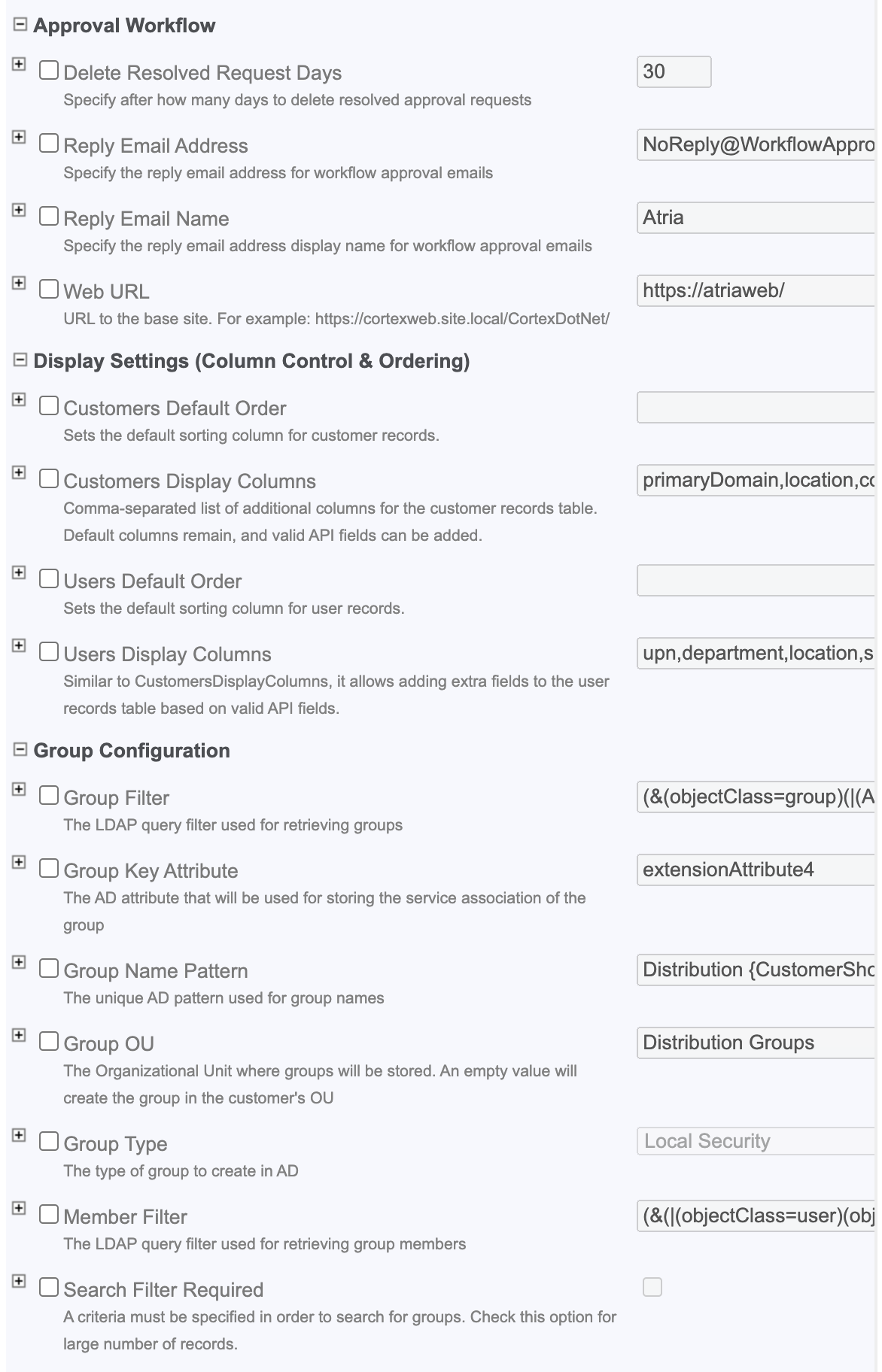

General Configuration
-
Allow Review Changes:
If set to True, it will display review changes before updating -
Bill Processing Day:
The day for Bill Processing to run. If the 29th, or 30th are selected, then Bill Processing will run on the EOM if the month has fewer days -
Can Unlock User Account:
Allow users to unlock their accounts on reset of their passwords -
Copy User Exclude Properties:
Specify a list of comma-separated user properties that should not be copied for a new user -
Customer OU Offset:
Optional offset to separate a Customer OU from its typical default location -
Customer OU Root Path:
Root AD Path for storing Customer OU’s for the Reseller -
Customer Roles Attribute:
Used for maintaining a list of user roles. Default: extensionAttribute13 -
Default First User Admin Role:
Default role added to the customer administrator on new customer creation -
Default Recovery Address:
Default Password recovery email address to primary email address if not explicitly set -
DNS Templates:
Enable DNS templates. Select this option if the DNS service is configured -
OU Hierarchy Enabled:
Store Customer OU’s in a hierarchical manner -
Root Customer Excludes Hierarchy:
If True, Service Provider is stored alongside child customers instead of as their parent -
Service Message:
A description about the service -
Set User Password to Change at Logon after reset:
After a user has their password reset, set the password to change at next logon -
UPN Domains:
Domains that can be used for a UPN suffix -
User Email Remove Diacritics Disabled:
Disable automatic conversion of special letters to standard letters e.g. umlauts -
UserQuotaLimit:
UserQuotaLimit -
X.500 Proxy Address Management:
Enable X.500 proxy address management
Approval Workflow
-
Delete Resolved Request Days:
Specify after how many days to delete resolved approval requests -
Reply Email Address:
Specify the reply email address for workflow approval emails -
Reply Email Name:
Specify the reply email address display name for workflow approval emails -
Web URL:
URL to the base site. For example: https://atriaweb
Display Settings (Column Control & Ordering)
-
Customers Default Order:
Sets the default sorting column for customer records. -
Customers Display Columns:
Comma-separated list of additional columns for the customer records table. Default columns remain, and valid API fields can be added. -
Users Default Order:
Sets the default sorting column for user records. -
Users Display Columns:
Similar to CustomersDisplayColumns, it allows adding extra fields to the user records table based on valid API fields.
Group Configuration
-
Group Filter:
The LDAP query filter used for retrieving groups -
Group Key Attribute:
The AD attribute that will be used for storing the service association of the group -
Group Name Pattern:
The unique AD pattern used for group names -
Group OU:
The Organizational Unit where groups will be stored. An empty value will create the group in the customer’s OU -
Group Type:
The type of group to create in AD -
Member Filter:
The LDAP query filter used for retrieving group members -
Search Filter Required:
A criteria must be specified in order to search for groups. Check this option for large number of records
Password Reset
- Self Password Reset Feature:
This is the field which needs to enable/disable self password reset functionality
Patterns
-
Customer OU Name:
Naming convention for the Customers OU name in Active Directory -
Display Name:
Enforces a default display name pattern for a user -
Email:
Enforces a default email pattern for a user -
OU Hierarchy:
OU Path pattern for storage of Customers in a hierarchical manner -
OU Non Hierarchy:
OU Path pattern for storage of Customers in a non hierarchical manner -
UPN:
Enforces a UPN when a UPN value is not specified -
Username:
Enforces a username pattern such as{UserInput}_{CustomerShortName}
Providers
-
Authentication:
Specify the path to a class that inherits from AuthenticationProvider -
Customer:
Specify the path to a class that inherits from CustomerProvider -
User:
Specify the path to a class that inherits from UserProvider
Summary
This article covers every configuration settings found in the Edit Customer and Customer Portal Settings menus. Make sure to click Apply Changes/ Provision to save your changes.
if you have any questions about the configuration options available, please contact us at support@getatria.com.